White spotting (Mantle and Platten)
The known genes responsible for white in Great Danes are the merle gene (M), the harlequin gene (H) and the white spotting gene (S). These do not work independently and the combination of these on the genetic level (genotype) has an effect on what dogs physically look like (phenotype).
Much has been said about merles and harlequins. But very little about piebald or Platten, as the FCI Standard refers to them. Platten dogs can and do appear in ethically bred harlequin litters. This is due to the role that the mantle pattern play in harlequin breeding.
The mantle and platten pattern is caused by the white spotting gene. The S-series, or white spotting (MITF gene) controls where there will be pigment on a dog. There are thought to be at least four alleles (sub categories) of this gene. How they combine in a dog will determine how much white is on the dog. These alleles are referred to as:
S (Solid)
No white to very little white on toes and chest.
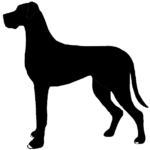
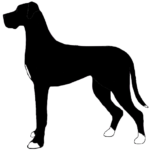
si (Irish Spotting)
White on face, chest, feet and tail tip. This range goes from black with some white on one end through heavily marked mantle to ideal mantle on the other end.

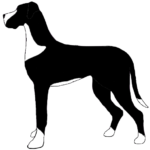
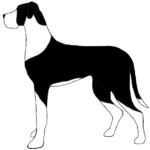
sp (Piebald/Platten)
Wide range from almost no white to almost all white with colour on head and tail root only. This range goes from black through mantle to very white platten.




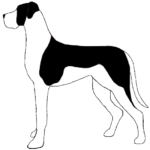
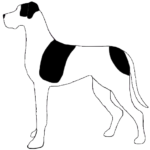

se (Extreme Piebald/Platten)
Almost entirely white with colour on the head only or a spot near the tail root.

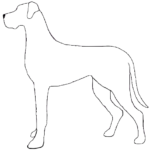
A dog has a combination of two of the alleles. For instance, SS will be a solid-coloured dog (with minimal white possible on toes and chest), and on the other extreme, sese will be almost entirely white with maybe a little colour on the head/ears or root of tail. Any other combination will be somewhere in the middle with sp being the most unpredictable, since it ranges from just inside of S to just inside se.
The colour patches on a mantle and platten are smooth edged, while those of a harlequin are jaggered. Also, platten and mantle are technically not colours, they are patterns (stencils) determining where colour can occur. Thus, you can have a black mantle, a mantle merle or a mantle harlequin (show marked harlequin). In the same way you can have a black platten, a platten merle or a platten harlequin (too lightly marked harlequin).
The reason harlequin breeders prefer not to use piebalds in their breeding program is the unpredictability of the pattern and effect the pattern will have on the placement of the harlequin (or merle) colour on the dog.
A show marked harlequin is a dog with evenly spaced torn patches on the body and head with a pure white collar and chest. This means only patches where an ideal mantle would have colour (a mantle harlequin).
The problem is that not any one of the s-series alleles produce only the perfect show marked mantle. And by merely looking at the dog (phenotype), you will never know what combination of the S series you have, except for the two extremes – solid with zero white and almost all white.
This is an extremely simplistic explanation of something that is very complicated and as yet not fully understood.
More reading:
What genes control white spotting in dogs?
MITF and White Spotting in Dogs: A Population Study
S-Locus (White Spotting, Piebald)
Testing of dogs: White spotting
A Simple Repeat Polymorphism in the MITF-M Promoter Is a Key Regulator of White Spotting in Dogs
